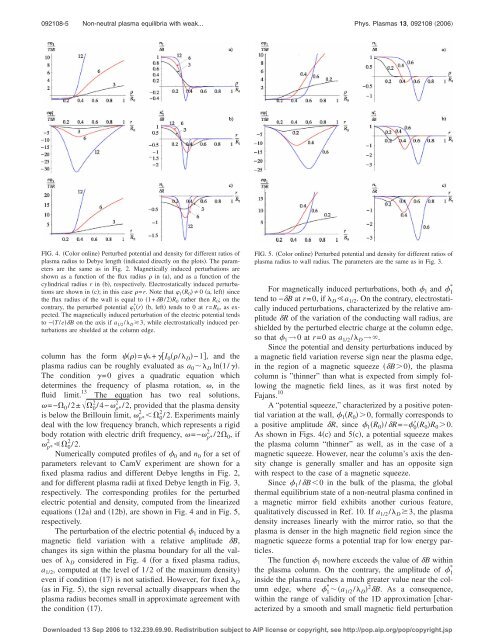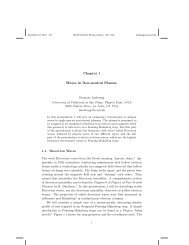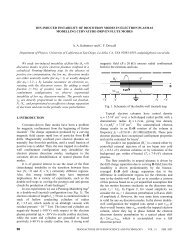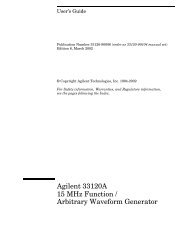Non-neutral plasma equilibria with weak axisymmetric magnetic ...
Non-neutral plasma equilibria with weak axisymmetric magnetic ...
Non-neutral plasma equilibria with weak axisymmetric magnetic ...
Create successful ePaper yourself
Turn your PDF publications into a flip-book with our unique Google optimized e-Paper software.
092108-5 <strong>Non</strong>-<strong>neutral</strong> <strong>plasma</strong> <strong>equilibria</strong> <strong>with</strong> <strong>weak</strong>... Phys. Plasmas 13, 092108 2006<br />
FIG. 4. Color online Perturbed potential and density for different ratios of<br />
<strong>plasma</strong> radius to Debye length indicated directly on the plots. The parameters<br />
are the same as in Fig. 2. Magnetically induced perturbations are<br />
shown as a function of the flux radius in a, and as a function of the<br />
cylindrical radius r in b, respectively. Electrostatically induced perturbations<br />
are shown in c; in this case =r. Note that 1 R 0 0 a, left since<br />
the flux radius of the wall is equal to 1+B/2R 0 rather then R 0 ; on the<br />
contrary, the perturbed potential 1 * r b, left tends to 0 at r=R 0 ,asexpected.<br />
The <strong>magnetic</strong>ally induced perturbation of the electric potential tends<br />
to −T/eB on the axis if a 1/2 / D 3, while electrostatically induced perturbations<br />
are shielded at the column edge.<br />
column has the form = * +I 0 / D −1, and the<br />
<strong>plasma</strong> radius can be roughly evaluated as a 0 D ln1/.<br />
The condition =0 gives a quadratic equation which<br />
determines the frequency of <strong>plasma</strong> rotation, , in the<br />
fluid limit. 13 The equation has two real solutions,<br />
=− 0 /2± 2 0 /4− 2 p* /2, provided that the <strong>plasma</strong> density<br />
is below the Brillouin limit, 2 p* 2 0 /2. Experiments mainly<br />
deal <strong>with</strong> the low frequency branch, which represents a rigid<br />
body rotation <strong>with</strong> electric drift frequency, =− 2 p* /2 0 ,if<br />
2 p* 2 0 /2.<br />
Numerically computed profiles of 0 and n 0 for a set of<br />
parameters relevant to CamV experiment are shown for a<br />
fixed <strong>plasma</strong> radius and different Debye lengths in Fig. 2,<br />
and for different <strong>plasma</strong> radii at fixed Debye length in Fig. 3,<br />
respectively. The corresponding profiles for the perturbed<br />
electric potential and density, computed from the linearized<br />
equations 12a and 12b, are shown in Fig. 4 and in Fig. 5,<br />
respectively.<br />
The perturbation of the electric potential 1 induced by a<br />
<strong>magnetic</strong> field variation <strong>with</strong> a relative amplitude B,<br />
changes its sign <strong>with</strong>in the <strong>plasma</strong> boundary for all the values<br />
of D considered in Fig. 4 for a fixed <strong>plasma</strong> radius,<br />
a 1/2 , computed at the level of 1/2 of the maximum density<br />
even if condition 17 is not satisfied. However, for fixed D<br />
as in Fig. 5, the sign reversal actually disappears when the<br />
<strong>plasma</strong> radius becomes small in approximate agreement <strong>with</strong><br />
the condition 17.<br />
FIG. 5. Color online Perturbed potential and density for different ratios of<br />
<strong>plasma</strong> radius to wall radius. The parameters are the same as in Fig. 3.<br />
For <strong>magnetic</strong>ally induced perturbations, both 1 and 1<br />
*<br />
tend to −B at r=0, if D a 1/2 . On the contrary, electrostatically<br />
induced perturbations, characterized by the relative amplitude<br />
R of the variation of the conducting wall radius, are<br />
shielded by the perturbed electric charge at the column edge,<br />
so that 1 →0atr=0 as a 1/2 / D →.<br />
Since the potential and density perturbations induced by<br />
a <strong>magnetic</strong> field variation reverse sign near the <strong>plasma</strong> edge,<br />
in the region of a <strong>magnetic</strong> squeeze B0, the <strong>plasma</strong><br />
column is ”thinner” than what is expected from simply following<br />
the <strong>magnetic</strong> field lines, as it was first noted by<br />
Fajans. 10<br />
A “potential squeeze,” characterized by a positive potential<br />
variation at the wall, 1 R 0 0, formally corresponds to<br />
a positive amplitude R, since 1 R 0 /R=− 0 R 0 R 0 0.<br />
As shown in Figs. 4c and 5c, a potential squeeze makes<br />
the <strong>plasma</strong> column “thinner” as well, as in the case of a<br />
<strong>magnetic</strong> squeeze. However, near the column’s axis the density<br />
change is generally smaller and has an opposite sign<br />
<strong>with</strong> respect to the case of a <strong>magnetic</strong> squeeze.<br />
Since 1 /B0 in the bulk of the <strong>plasma</strong>, the global<br />
thermal equilibrium state of a non-<strong>neutral</strong> <strong>plasma</strong> confined in<br />
a <strong>magnetic</strong> mirror field exhibits another curious feature,<br />
qualitatively discussed in Ref. 10. If a 1/2 / D 3, the <strong>plasma</strong><br />
density increases linearly <strong>with</strong> the mirror ratio, so that the<br />
<strong>plasma</strong> is denser in the high <strong>magnetic</strong> field region since the<br />
<strong>magnetic</strong> squeeze forms a potential trap for low energy particles.<br />
The function 1 nowhere exceeds the value of B <strong>with</strong>in<br />
the <strong>plasma</strong> column. On the contrary, the amplitude of 1<br />
*<br />
inside the <strong>plasma</strong> reaches a much greater value near the column<br />
edge, where 1 * a 1/2 / D 2 B. As a consequence,<br />
<strong>with</strong>in the range of validity of the 1D approximation characterized<br />
by a smooth and small <strong>magnetic</strong> field perturbation<br />
Downloaded 13 Sep 2006 to 132.239.69.90. Redistribution subject to AIP license or copyright, see http://pop.aip.org/pop/copyright.jsp








![WORKSHOP PARTICIPANTS LIST [pdf] - UC San Diego](https://img.yumpu.com/35298899/1/190x245/workshop-participants-list-pdf-uc-san-diego.jpg?quality=85)
